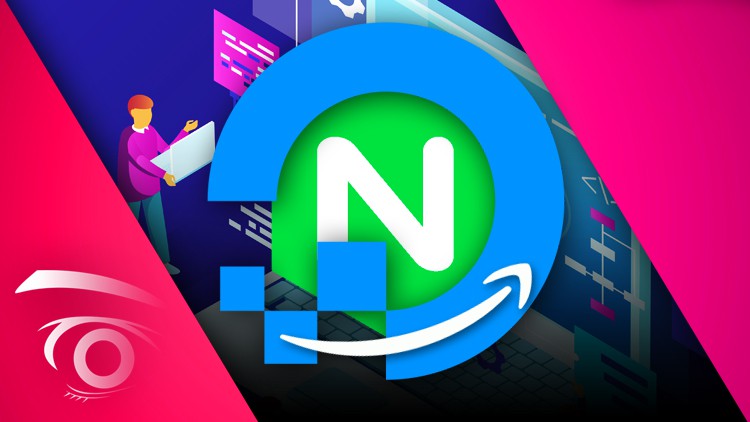
Digital Ocean | NGINX | LEMP Stack | Domain Names | SSL | WordPress | AWS Foundations | Amazon EC2 | AWS Storage | ELB
What you will learn
Understand the key features and differences between Apache and NGINX servers, and choose the right server for specific use cases.
Set up and configure a Digital Ocean account, create a new droplet, and deploy a LEMP stack on Ubuntu.
Install and configure a LEMP stack on Ubuntu, including setting up Nginx, MySQL, and PHP.
Configure Nginx as a reverse proxy, and leverage various Nginx modules to optimize web application performance.
Configure Nginx as a reverse proxy, and leverage various Nginx modules to optimize web application performance.
Register a domain name, configure DNS settings, and secure web applications using SSL encryption.
Install and configure WordPress on an NGINX server, including setting up the necessary database and configuring Nginx as a reverse proxy.
Understand the architecture, features, and key services available on the AWS platform, including EC2, S3, and RDS.
Set up and configure an AWS account, and explore various AWS tools and technologies.
Create and configure EC2 instances, including setting up security groups, configuring networking, and selecting the right instance type for specific use cases.
Leverage various EC2 features and understand how to optimize instance performance.
Configure and manage AWS storage solutions, including EBS to support EC2 instances.
Understand how to use load balancers and auto scaling groups to optimize application performance and availability.
Set up and configure Route 53 to manage DNS settings.
Gain practical experience through hands-on labs and exercises.
Apply foundational concepts and practical skills to real-world use cases.
Understand how to choose the right technology solutions to meet specific requirements.
Description
This course provides students with a comprehensive overview of foundational concepts and practical skills required to deploy web applications using Apache and NGINX servers, configure and manage cloud servers on Digital Ocean and AWS platforms, and leverage various AWS storage solutions to support EC2 instances.
The course begins by introducing the foundational concepts of Apache and NGINX servers. Students learn about the architecture, configuration, and key features of both servers, while exploring how to deploy and configure them to host web applications. We also teach the key differences between Apache and NGINX and the best use cases for each web server technology.
Next, the course covers cloud server deployment on Digital Ocean. Students learn how to set up and configure a Digital Ocean account and create a new droplet. They will also explore various tools and technologies available on the Digital Ocean platform and learn how to leverage them to build and deploy web applications.
The course then delves into LEMP stack configuration on Ubuntu. Students will learn how to install and configure LEMP stack on Ubuntu, including setting up Nginx, MySQL, and PHP. We teach how to configure Nginx as a reverse proxy and leverage various Nginx modules to optimize web application performance.
Next, the course covers domain name registration and SSL encryption. Students will learn how to register a domain name, configure DNS settings, and secure web applications using SSL encryption. They will also explore various SSL certificate providers and understand how to choose the right certificate for their use case.
The course then moves on to WordPress installation and configuration on NGINX. Students will learn how to install and configure WordPress on a NGINX server, including setting up the necessary database and configuring Nginx as a reverse proxy. They will also explore various WordPress plugins and themes and understand how to customize them to meet specific requirements.
From here, we dive into AWS foundations. Students learn about the architecture, features, and key services available on the AWS platform, including EC2 and IAM. They will also understand how to set up and configure an AWS account and explore various AWS tools and technologies.
Next, the course covers Amazon EC2 foundations. Students learn to create and configure EC2 instances, including setting up security groups, configuring networking, and selecting the right instance type for specific use cases. They will also explore various EC2 features and understand how to leverage them to optimize instance performance.
The course then moves on to AWS storage solutions for EC2. Students will learn about various AWS storage solutions, including EBS, S3, and Glacier. They will understand how to configure and manage these storage solutions to support EC2 instances, and explore various use cases where different storage solutions may be appropriate.
Finally, the course covers AWS Elastic Load Balancing, Auto Scaling Groups, and Route 53. Students will learn how to set up and configure load balancers and auto scaling groups, and understand how to use Route 53 to manage DNS settings. They will also explore various use cases where load balancing, auto scaling, and Route 53 may be necessary to optimize application performance and availability.
Overall, this course provides students with a comprehensive overview of foundational concepts and practical skills required to deploy web applications using Apache and NGINX servers, configure and manage cloud servers on Digital Ocean and AWS platforms, and leverage various AWS storage solutions to support EC2 instances. Students will also gain practical experience through hands-on labs and exercises, and understand how to apply these concepts and skills to real-world use cases.
Content
Introduction
Virtual Server Basics
Install and Configure LEMP Stack on Ubuntu
Domain Names and SSL
PhpMyAdmin on NGINX
WordPress on NGINX
Getting Started with AWS
Amazon Elastic Compute Cloud (EC2)
AWS Storage (EC2)
AWS ELB, ASG, Route 53